
1
Dunes carpeted with Wildflowers
The Pinnacles Desert is surrounded by Dunes which are carpeted with Wildflowers during Spring
| 
2
Rose Banjine (Pimelea rosea)
| 
3
Rose Banjine (Pimelea rosea) close-up
|

4
Common Clematis (Clematis pubescens)
| 
5
Thick-leaved Fanflower (Scaevola crassifolia)
| 
6
Silky Hemigenia (Hemigenia incana)
|
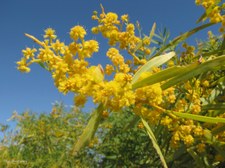
7
Wattle (Acacia species)
| 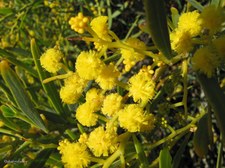
8
Wattle (Acacia species)
| 
9
Mike is a dedicated Tour Guide
'Turquoise Coast Enviro Tours'
www.thepinnacles.com.au
|
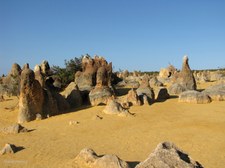
10
Entering the Pinnacles Desert
Nambung National Park, Western Australia.
Located on the Swan Coastal Plain, 260 kms north of Perth.
| 
11
Pinnacles formations
The formation of the Pinnacles would have taken many thousands of years.
| 
12
Vegetation beside Pinnacle
In winter, rain, which is slightly acidic, dissolves small amounts of calcium carbonate as it percolates down through the sand.
|
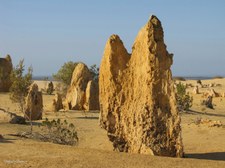
13
The Pinnacles Desert
As the dune dries out during summer, this is precipitated as a cement around grains of sand in the lower levels of the dunes, binding them together and eventually producing a hard limestone rock.
| 
14
The Pinnacles Desert
At the same time, vegetation that became established on the surface, aided this process. Plant roots stabilised the surface, and encouraged a more acidic layer of soil and humus (containing decayed plant and animal matter) to develop over the remaining quartz sand.
| 
15
In Shadow of encroaching Sand Dune
The acidic soil accelerated the leaching process, and a hard layer of calcrete formed over the softer limestone below.
|
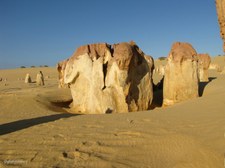
16
'Chocolate-coated' Pinnacles
Cracks which formed in the calcrete layer were exploited by plant roots.
| 
17
The Pinnacles Desert
When water seeped down along these channels, the softer limestone beneath was slowly leached away and the channels gradually filled with quartz sand.
| 
18
The Pinnacles Desert
This subsurface erosion continued until only the most resilient columns remained.
|

19
Emu Footprint in the Sand
The Pinnacles, are the eroded remnants of the formerly thick bed of limestone.
| 
20
The Pinnacles Desert
As bush fires denuded the higher areas, south-westerly winds carried away the loose quartz sands and left these limestone pillars standing up to three and a half metres high.
| 
21
The Pinnacles Desert
Although the formation of the Pinnacles would have taken many thousands of years, they were probably only exposed in quite recent times.
|

22
Yellow Sands of the Pinnacles
Aboriginal artefacts at least 6,000 years old have been found in the Pinnacles Desert despite no recent evidence of Aboriginal occupation.
| 
23
Pinnacles Landscape
This tends to suggest that the Pinnacles were exposed about 6,000 years ago and then covered up by shifting sands, before being exposed again in the last few hundred years.
| 
24
White Sand Dunes in the Distance
This process can be seen in action today - with the predominantly southerly winds uncovering pinnacles in the northern part of the Pinnacles Desert but covering those in the south.
|
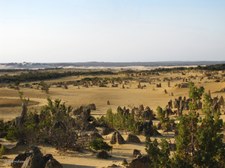
25
The Pinnacles
Over time, the limestone spires will no doubt be covered again by other sand drifts and the cycle repeated, creating weird and wonderful shapes over and over again.
| 
26
The Pinnacles
The first known European recording of the Nambung area dates back to 1658, when the North and South Hummocks first appeared on Dutch maps.
| 
27
The Pinnacles
The Hummocks were also mentioned in navigator Philip Parker King's journal in about 1820.
|

28
The Pinnacles
Nambung is an Aboriginal word that means crooked or winding and it was from this river that the park was named.
| 
29
The Pinnacles
The Pinnacles Desert remained relatively unknown until the late 1960s, when the Department of Lands and Surveys agreed to add the area to the already existing national park, which had been established in 1956.
| 
30
The Pinnacles
Today the park is visited by approximately 250,000 visitors, from all over the world, each year.
|

31
The Pinnacles
Information courtesy:--
http://www.dec.wa.gov.au/hotproperty/property/national-parks/nambung-national-park-pinnacles.html
| 
32
The Pinnacles
Nambung National Park, Western Australia
| 
33
Parrotbush (Dryandra sessilis)
|

34
Opening flower of Parrotbush (Dryandra sessilis)
| 
35
The Pinnacles
Nambung National Park, Western Australia
| 
36
The Pinnacles
Nambung National Park, Western Australia
|

37
Galahs perched on a Pinnacle
Galahs(Cacatua roseicapilla)are common in Nambung National Park.
| 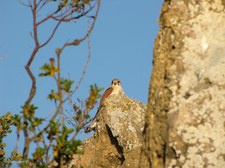
38
Nankeen Kestrel (Falco cenchroides)
This bird of prey is also known as Australian Kestrel.
| 
39
Nankeen Kestrel (Falco cenchroides)
|

40
The Pinnacles
Nambung National Park, Western Australia
| 
41
The Pinnacles
Nambung National Park, Western Australia
| 
42
'The Three Warriors'
Nambung National Park, Western Australia
|

43
Pair of Galahs
Galahs form permanent bonds with their partner and this pair nest in a hollow in the top of this Pinnacle. Rain does not flood the nest because there is a crack which drains the water away.
| 
44
Galah (Cacatua roseicapilla)
| 
45
Galah (Cacatua roseicapilla)
|

46
Galah (Cacatua roseicapilla)
| 
47
Pinnacles and Parrot Bush
Nambung National Park.
| 
48
The Pinnacles Desert
Nambung National Park.
|

49
The Pinnacles Desert
As the wind swirls around each Pinnacle, the sand is moved to form a basin around the base.
| 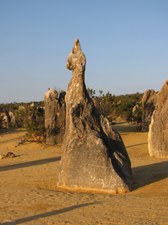
50
The Pinnacles Desert
Can you imagine a kangaroo facing north?
| 
51
The Pinnacles Desert
Same Pinnacle viewed from the other side, now the kangaroo is facing south.
|

52
Shadows are getting Longer
| 
53
Late afternoon at The Pinnacles
Nambung National Park.
| 
54
The Pinnacles in the Golden Glow
Nambung National Park.
|

55
The Pinnacles Desert
Nambung National Park.
| 
56
The Pinnacles Desert
Nambung National Park.
| 
57
The Pinnacles Desert
Nambung National Park.
|
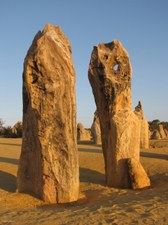
58
The Pinnacles Desert
Nambung National Park.
| 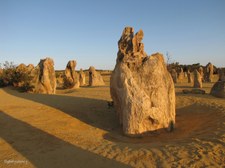
59
The Pinnacles Desert
Nambung National Park.
| 
60
The Pinnacles Desert
Nambung National Park.
|

61
The Pinnacles Desert
Nambung National Park.
| 
62
The Pinnacles Desert
Nambung National Park.
| 
63
The Pinnacles Desert
Nambung National Park.
|

64
The Pinnacles Desert
Nambung National Park.
| 
65
The Pinnacles Desert
Nambung National Park.
| 
66
The Pinnacles Desert
Nambung National Park.
|

67
The Pinnacles Desert
Nambung National Park.
| 
68
The Pinnacles Desert
Nambung National Park.
| 
69
The Pinnacles Desert
Nambung National Park.
|
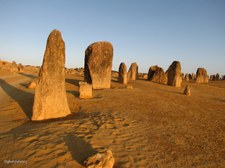
70
The Pinnacles Desert
Nambung National Park.
| 
71
The Pinnacles Desert
Nambung National Park.
| 
72
The Pinnacles Desert
Nambung National Park.
|

73
Fossilised Root in the Pinnacle
Nambung National Park.
| 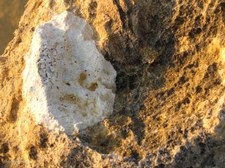
74
Lichen on the Pinnacle
Nambung National Park.
| 
75
The Pinnacles Desert
Nambung National Park.
|

76
White Sand Dunes in the Distance
Nambung National Park.
| 
77
White Sand Dunes in the Distance
Nambung National Park.
| 
78
Boardwalk to the Lookout
Nambung National Park.
|

79
View 1 from Lookout
Nambung National Park.
| 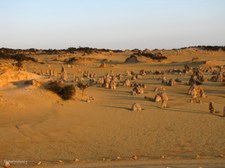
80
View 2 from Lookout
Nambung National Park.
| 
81
View 3 from Lookout
Almost time for Sunset at Nambung National Park.
|

82
Woodbridge Poison near Lookout
Isotoma hypocrateriformis, an erect, succulent annual herb which grows on sand, granite or laterite.
| 
83
Woodbridge Poison
Isotoma hypocrateriformis, near Lookout.
| 
84
Sunset at The Pinnacles 1
|

85
Sunset at The Pinnacles 2
| 
86
Sunset at The Pinnacles 3
| 
87
Sunset at The Pinnacles 4
|

88
Sunset at The Pinnacles 5
| 
89
Sunset at The Pinnacles 6
| 
90
Sunset at The Pinnacles 7
|
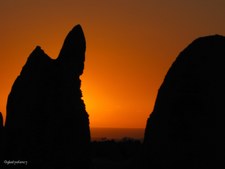
91
Sunset at The Pinnacles 8
| 
92
Sunset at The Pinnacles 9
| 
93
Sunset at The Pinnacles 10
|

94
Sunset at The Pinnacles 11
| 
95
Sunset at The Pinnacles 12
| 
96
Sunset at The Pinnacles 13
|

97
Sunset at The Pinnacles 14
| 
98
Sunset at The Pinnacles 15
| 
99
Sunset at The Pinnacles 16
|

100
Sunset at The Pinnacles 17
| 
101
Sunset at The Pinnacles 18
| 
102
Sunset at The Pinnacles 19
|

103
Sunset at The Pinnacles 20
| 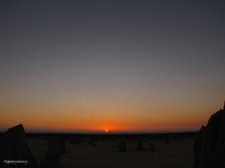
104
Sunset at The Pinnacles 21
| 
105
Sunset at The Pinnacles 22
Thankyou Mike for a fantastic Sunset Tour of The Pinnacles.
|